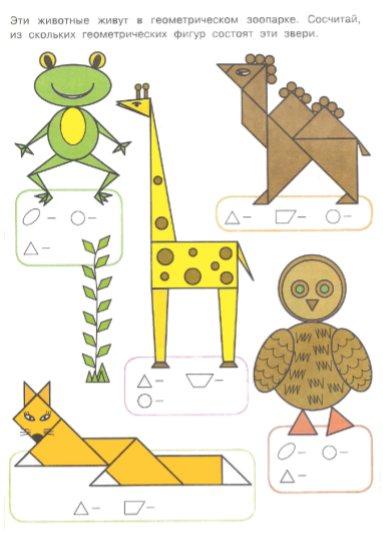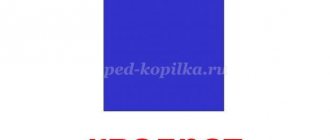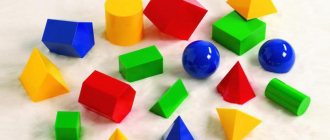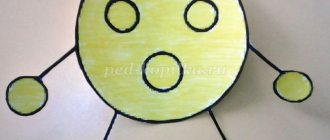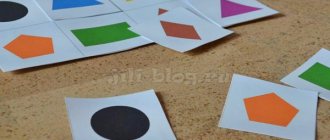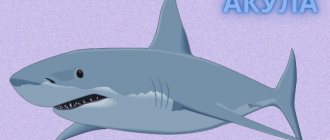Target:
- Study of similar and dissimilar figures (circle, square, triangle) their size and shape.
- To develop the ability to see a contour drawing with an overlay.
- Development of geometric imagination and creative abilities.
- Developing the ability to see the whole before the parts.
Material:
Three squares and 3 circles of different sizes and colors, 3 triangles of different sizes, shapes and colors; 3 squares, 3 circles of the same size and shape; 3 triangles of the same size and different shapes from the “Geometric Chest” manual. Each person has three right triangles on the table, cut out according to this pattern:
Kusener's sticks. “Pack your suitcase” guide.
Part I. Fairy tale “How the wizard Putalka changed geometric figures.”
Progress of the lesson
“The wizard Confusion had a magic wand with which he could increase and decrease any things and even geometric shapes. He had 3 squares, 3 circles and three triangles. Note:
the triangles must be different in size and shape.
He took his magic wand and enlarged one square and reduced the other. And he ended up with identical squares...”
Replace the squares so that they are the same. Check their equality by overlapping. “... Then he took the circles and did the same with them. He decided to do the same with triangles. – Are the triangles the same? Let's check it with an overlay. Why don't the triangles match? After all, Confusion enlarged the small triangle and reduced the large one. They are the same in size, but in shape?
We will check that they are all different in shape (demonstrate again by overlapping triangles).
– Are circles and squares different in shape or the same? (Show them in overlay)
Part II Game “Make an Object from Figures”
From 2 small and 1 large triangles, fold: herringbone, house, square (no pattern!).
Part III. Physical education session with movements “Seasons”.
The teacher reads a poem to the children, showing the movements. Then the children, together with the teacher, perform them, pronouncing the words.
We play snowballs in winter
(
Children “throw snowballs.”) We plant seeds in the spring, (“They sow.”) We rest in the hot summer, (We fan ourselves.) In the fall we pick fruits. (“They pick fruits from the tree.”)
Part IV Game “Part and Whole”.
The teacher divides the group in half: one gives cards with a picture of the whole, the other with a part. Children must find a part of the whole by working in pairs.
Part V. Game “Pick up the lid.”
The teacher gives half the group bottles or jars without lids, and the other half - lids from them. Children with caps must find matching bottles and screw them on with their own caps. The game is repeated, but now those who had caps get bottles, and vice versa.
Part VI Game exercise “Find”.
The children have Kusener sticks on their tables. Find the longest stick and the shortest one, name their colors. Children make a colored ladder from sticks, the teacher helps them. The colors of the sticks are called.
VII part. Game “Kusener’s Sticks”
Make a house for a bunny out of Kusener sticks (without a sample). At the end of the task, the children walk around and see what kind of houses they turned out to be.
Part VIII Game “Card exercises”.
The teacher shows cards with schematic representations of movements, and the children perform them.
IX part. Game “Geometric chest”.
The teacher draws a sequence (“snake”) of geometric shapes on the board: for example, circle, square, triangle, circle, square, triangle. Children should continue the row on their table using the figures from the Geometric Chest manual.
X hour Game “Pack your bags”
.
The teacher tells them that they need to help pack things into suitcases for the trip, but each item should only be in the suitcase that has its outline depicted on it. The teacher gives each child a card with a picture of a thing, then lays out “suitcases” on the carpet. Children take turns and look for which suitcase to put the item in.
XI hour. Result.
- Well done! You did a good job. - Guys, did you like working out? – What games did we play? – What was difficult to do? – What’s easy?
MAGAZINE Preschooler.RF
Summary of educational activities in the middle group “Magic figures in mathematics”Goal: Learn to distinguish and name geometric shapes: square, circle, triangle, rectangle; learn to navigate in space; practice counting to five.
Tasks:
Educational:
- Expand children's knowledge about shapes, teach them to group them by color and size.
Educational:
- Develop observation and attentiveness.
- Develop memory, thinking and speech.
Educational:
- Stimulate interest in mathematics.
- To develop skills of cultural behavior in society.
Materials:
Geometric figures; a picture of a house with cut holes in the form of geometric shapes; geometric shapes on magnets that fit these holes; magnetic board; four boxes of different colors: green, blue, yellow, red; geometric shapes according to the number of children of different colors, short and long boards; trees high and low; envelopes.
Progress of the lesson.
Educator (shows envelopes): We have received letters from fairy-tale characters who ask us for help. Well, shall we help them? Children: Yes. Educator: Then I invite all children
He'll hit the road soon. Teacher (opens the first envelope): This is a letter from Dunno. He writes that he forgot what geometric figures are called. Our first task. Come to the table. There are different figures on the table. You need to take one figure at a time and say what kind of figure it is and how many angles it has.
(Children each take a figure from the table and clearly name the figure they took and the number of angles in the figure).
Educator: Well done guys, you all answered correctly. Now Dunno will remember the names of geometric shapes. We completed the first task correctly. Let's move on to the second task (opens the second envelope). This is a letter from Leopold the cat. He writes that mice have gnawed through the walls of his house and asks for help. Shall we help? Children: Yes. (On the magnetic board there is a large picture of a house, with holes cut out in the form of geometric shapes). Educator: Tell me, to close this hole, what figure should we take? (Child’s answer, and the child puts the piece to the hole). What figure should I use to close this hole? (Answer from the next child. This closes all the holes.) Well done. Now Leopold the cat has all his walls intact and he says thank you. Educator: Let's take a little break and do some exercises. One two three four five. We all know how to count. Once, they stood up and stretched. Two - bent, straightened up. Three - three claps of the palms, three nods of the head. By four – your arms are wider. Five - wave your arms. Teacher (opens the next envelope): This is a letter from the three little pigs. They write that they had boxes with multi-colored figures. But the gray wolf mixed up all the figures, and they cannot collect them by color. Shall we help the piglets? Children: Yes.
(Figures of different colors are scattered on one table. On another table there are four boxes of different colors.)
Educator: Guys, you need to collect and group the shapes by color and then put them in boxes.
(Children complete the task).
Educator: Well done, guys. You completed the task. And now let's open the last envelope. It is from the Good Fairy. What is she writing to us? (Opens and reads):
“Go to the river, pick up a bridge to cross the river. When you cross the bridge, turn right and you will see trees. A surprise awaits you under a low tree . (Large geometric shapes lie on the floor next to the river.) Educator: How do we find a bridge? Children: We will put figures on the river. (Apply all the figures one after another). Educator: Which figure will you choose? Children: Rectangle. Educator: Why? Children: Because this figure reaches from shore to shore. Educator: How can you find out which board is long and which is short? (Children complete the task, cross the river across the bridge). Educator: Now you need to turn right. Where is the right side? And here are the trees. Where is the tall tree? Where is the low? (children show and find a box under a low tree). Here is a treat for you from the good Fairy. Educator: Children, did you like our trip? Who did we help today? What have we done for this? (children's answers). Well done!
| Next > |
Summary of the Oud "Magic Figures"
Summary of organizational educational activities for FEMP “Magic Figures” (second junior group)
Educational area:
“Cognition”
Section:
“FEMP”
Tasks:
Teach children to distinguish and correctly name geometric figures, consolidate knowledge of primary colors: green, red, blue, yellow, exercise children in examining patterns of figures in different ways (tracing the outline of a figure with a finger; drawing the outline of a figure in the air; rolling a geometric figure; feeling a geometric figure with hands ), name objects of round, square and triangular shape, consolidate the ability to determine the size of objects, reflect the result of comparison in speech: large, small, smaller, high - low, shortest, longest and longest. To develop imaginative thinking, imagination, and memory in children. Cultivate perseverance and cognitive interest in the lesson.
Morning circle:
- Hello, sun!
- Hello, sky!
- Hello, all my land!
—
We woke up very early! - And we welcome you!
Progress of the lesson:
Surprise moment: I invite the children to join the group.
Guys, look how beautiful it is in our group. An exciting journey awaits us today. Look at the balls, what color do you see the balls? That's right, our group is decorated with red, green, blue and yellow balls. Look, there are still three paths that lead to the houses. Guys, are the tracks all the same?
- What are they like? (Children's answers).
— That's right, they are all different in color and length.
- Let's take the shortest path.
-Look at the house we came to (the small one).
-Do you want to know who lives in the smallest house?
- And for this you need to guess the riddle:
Jumps deftly, gnaws carrots... who is this? (Hare)
- Guys, the bunny has prepared cards for us and wants to see how we know geometric shapes (shows geometric shapes: circle, square, triangle). (Children, without difficulty, name geometric shapes).
- Well done, the bunny is very glad that you know geometric shapes and has prepared a surprise for you:
Physical exercise:
“
Mice”
One day the mice came out.
See what time it is.
One, two, three, four - the mice pulled the weights.
Suddenly there was a terrible thunder -
The mice ran away.
-We rested a little, and now you and I are going further and will follow the blue path.
-Tell me, please, which track is longer, red or blue?
-That's right, the blue path is longer.
-Which house do you see? (big)
-Let's find out who lives in this house: I'll tell you a riddle and you can guess it. Fluffy tail, golden fur, lives in the forest, steals chickens in the village! (fox)
-Well done! The fox invites you to play a game called “Build Houses.”
— There are geometric shapes in a box on the table, you will need to make a house for the fox out of them.
-What beautiful houses you have made!
-Andryusha, what color is your house? What figures does it consist of?
- Guys, did your houses all turn out the same or different?
- Guys, look, we have one more path left, what is its size and color?
— That’s right, this path is the longest and it’s green.
— Follow me along the green path. What house do you see near the green path? (big)
-Now tell me, which house is bigger, on the blue path or on the green one? (children's answers)
- I wonder who lives in such a big house, let's solve the riddle and find out who lives here:
Clumsy, clubfooted, when he sleeps, he sucks his paw,
He eats raspberries, loves honey, and his name? (bear)
-Mishka wants to play the game “Find Your Place” with you, for this I will give you medals with the image of a geometric figure, and you will need to find a chair with the same figure and sit on it.
— Guys, who did we visit today?
- How many paths have we walked? Let's count.
— What color were the paths?
—Which path was the longest?
- Which path was the shortest?
- Well done! The bunny, fox and bear really enjoyed playing with you today, but they need to go to the forest to see their children. Children say goodbye to animals.
Lesson notes for educators and teachers
Topic: Geometric shapes
Goal: To consolidate concepts about geometric shapes. Summarize knowledge about the properties of shapes
(color, size). Strengthen ordinal counting within 10. Enrich your vocabulary.
Develop logical thinking, tactile and long-term memory, proper breathing, listening skills, fine motor skills.
Cultivate accuracy and self-control.
PROGRESS.
Psycho-gymnastics.
-Look how many guests have come to us, say hello to the guests. -Sit more comfortably on a chair, close your eyes and listen - how is it in our office? Quiet or loud?
-Now close your eyes and listen to what is happening behind the door. - Loud, why loud?
-Someone is knocking on our door, someone is probably late for our lesson. Let's invite a guest.
-Look, this is a box, what geometric shape does the side of the box resemble? And this?
A box with something written on it. -Let's read it! Can you help me?
- Parcel for Maxim.
- Who is Maxim? So this is for you. Let's see what's inside it. -This is a package of tasks and we need to complete them.
Envelope No. 1
-There are geometric shapes in the envelope, name them.
-Using the same figures, you can create new geometric
figures.
-Attach these figures first. Then, without looking into the bag, by touch find the figures that I will name.
-Well done, you completed the task! Let's move on to the next task
-Take the envelope with the number 2 written on it.
Envelope No. 2
-What do I have? This is a frame. What shape is it? What geometric shapes does it consist of?
-Now we will make a square from different figures. What color is the square, what shapes did you make it from, how many corners, how can I say it differently?
- Well done, you did it. Let's put our squares in the parcel.
-Now what number is the next envelope?
Envelope No. 3
-Look what's in the envelope? We need the lace for the next task.
-After all, with the help of geometric shapes, you can not only create new shapes and assemble the shapes themselves using different ones. But the objects of our life themselves symbolize geometric shapes. Now, we need to match the figure with the object using laces.
-Well done! Let's move on to the next task. Envelope with number 4
Envelope No. 4
-What is this? What do we need the tube for? You can also breathe into it.
-You will blow into the tube so as to roll the ball to the top and hit
hole.
Envelope No. 5
-Here we have drawn figures, you need to draw them with the help of a ball, but at the same time close your eyes.
-Well done!
Envelope No. 6
-We have a marker. And we need to solve examples.
-I really liked the way you solved the examples.
-Let's see what we have in the next envelope under the number 7
Envelope No. 7
And we have geometric shapes. Tell me we can make something out of
these figures. Build what you want.
What or Who did you depict? What else can be built?
And what's in the last envelope? What number...
Envelope No. 8
And here is a cutaway picture. Let's collect it. And we will have the task on the computer.
- Help the car get to the house by choosing the correct path from the shapes
- Help the car get to the house by choosing the correct path by color.
- Look at the lights of the house and remember them. Now put them the way they were for me.
4. Tell me what time of year it is? It's cold outside and icicles will appear soon. I already have icicles, I just need to paint them.
Result: name the figures we talked about. Which group can we unite into? What is another name for them? What are these figures?
Maxim, look at our parcel - it has become a great parcel of your knowledge.
Source: https://konspekty-zanyatij.ru/uchebnye-materialy/konspekt-zanyatiya-po-femp-v-starshej-gruppe-geometricheskie-figury/
Geometric figures
It will be easy and in a playful way for your child to remember their names.
Geometric Zoo
